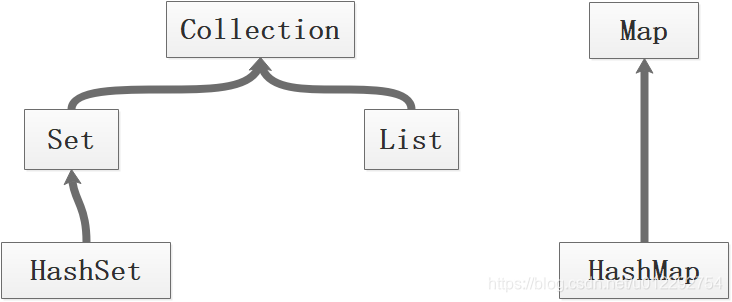版权声明:本文为博主原创文章,未经博主允许不得转载。 https://blog.csdn.net/u012292754/article/details/86513522
1 Collection
java.util.Collection接口是 Collection 层次结构中的根接口,它定义了一些最基本的访问方法;

2 测试 ArrayList
import java.util.ArrayList;
import java.util.Date;
import java.util.List;
/*
* ArrayList : 底层用数组实现。查询快;修改,插入,删除慢
* LinkedList: 底层实现是链表;查询慢,修改,插入,删除快
*
* Vector: 底层用数组,线程安全
*
* */
public class Test01 {
public static void main(String[] args) {
List list = new ArrayList();
list.add("AAA");
list.add(1234);
list.add(new Date());
System.out.println(list.size()); // 3
List list2 = new ArrayList();
list2.add("BBB");
list2.add("CCC");
list.add(list2);
System.out.println(list.size()); // 4
String str = (String) list.get(0);
System.out.println(str);
list.set(1,"aaa");
}
}
3 自己实现 ArrayList
package day04.collection;
public class MyArrayList {
private Object[] elementData;
private int size;
public MyArrayList() {
this(10);
}
public MyArrayList(int initialCapacity) {
if (initialCapacity < 0) {
try {
throw new Exception();
} catch (Exception e) {
e.printStackTrace();
}
}
elementData = new Object[initialCapacity];
}
public int size() {
return size;
}
public boolean isEmpty() {
return size == 0;
}
public void add(Object obj) {
if (size == elementData.length) {
Object[] newArray = new Object[size * 2 + 1];
System.arraycopy(elementData, 0, newArray, 0, elementData.length);
elementData = newArray;
}
elementData[size] = obj;
size++;
}
public Object get(int index) {
if (index < 0 || index >= size) {
try {
throw new Exception();
} catch (Exception e) {
e.printStackTrace();
}
}
return elementData[index];
}
public void remove(int index) {
if (index < 0 || index >= size) {
try {
throw new Exception();
} catch (Exception e) {
e.printStackTrace();
}
}
int numMoved = size - index - 1;
if (numMoved > 0) {
System.arraycopy(elementData, index + 1, elementData, index, numMoved);
}
elementData[--size] = null;
}
public void remove(Object obj) {
for (int i = 0; i < size; i++) {
if (get(i).equals(obj)) {
remove(i);
}
}
}
public Object set(int index, Object obj) {
rangeCheck(index);
Object oldValue = elementData[index];
elementData[index] = obj;
return oldValue;
}
public void add(int index, Object obj) {
rangeCheck(index);
ensureCapacity();
System.arraycopy(elementData, index, elementData, index + 1,
size - index);
elementData[index] = obj;
size++;
}
private void ensureCapacity(){
if (size == elementData.length) {
Object[] newArray = new Object[size * 2 + 1];
System.arraycopy(elementData, 0, newArray, 0, elementData.length);
elementData = newArray;
}
}
private void rangeCheck(int index) {
if (index < 0 || index >= size) {
try {
throw new Exception();
} catch (Exception e) {
e.printStackTrace();
}
}
}
public static void main(String[] args) {
MyArrayList list = new MyArrayList(3);
list.add("AAA");
list.add("BBB");
list.add("CCC");
list.add("DDD");
System.out.println(list.size());
}
}